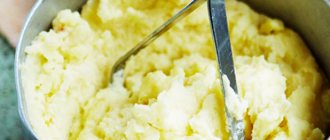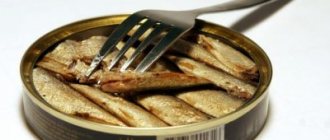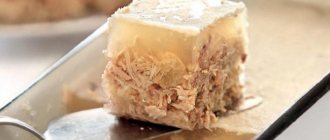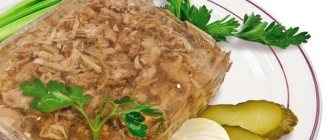How to properly store eggs in the refrigerator, which end?
Depending on which side you place the product inside the refrigerator, you can slightly extend the shelf life. To achieve long-term storage, you need to point the sharp end down. This way the content will be more static. In addition, on the opposite side there is an air gap that is not blocked by anything.
See also
Rules and best ways to store flour at home
Acceptable shelf life in the refrigerator
The period during which eggs can be stored depends directly on environmental conditions. If you follow all the manufacturer's recommendations, the maximum shelf life reaches 45 days.
For raw eggs
Storing raw food in the refrigerator has several features. Dietary eggs are considered the most useful; they can be stored for no more than a day in order to obtain the maximum amount of nutrients. After 24 hours, the product is considered a table product and is suitable for consumption with minimal heat treatment for the next 25 days.
In the future, eggs can be stored for up to 45 days and consumed only if they are hard-boiled in the shell.
For boiled eggs
Boiled eggs should not be left in the refrigerator for a long time. It is recommended to consume the finished product no later than 5 days.
Hard Boiled
Hard-boiled eggs can also be stored in the refrigerator, but the appropriate temperature for them should vary between 2-4 degrees. Immediately after cooking, it is recommended to place the product in a cool liquid and then transfer it to an airtight plastic container. Such preservation measures will prevent the absorption of foreign odors, since the porous shell has the property of absorbing surrounding aromas. The shelf life, subject to the above conditions, is 2 weeks.
Soft-boiled
If the product is soft-boiled, heat treatment does not exceed 3 minutes. The cooking method assumes that the yolk will remain liquid, and this affects the shelf life. The maximum shelf life is 48 hours, after which there is a high risk of poisoning if consumed.
Duration of storage of broken eggs
Damage to the integrity of the shell negatively affects the shelf life and leads to deterioration of the product over time. Broken specimens should be prepared as quickly as possible. It is recommended to store them for no more than 48 hours in a hermetically sealed container.
Period and conditions of storage in the freezer
If stored in the freezer, the shelf life is longer than in the refrigerator. To ensure that the product does not lose its taste and consistency, you must follow simple instructions:
- Break the eggs into a bowl. Since the contents increase in volume during freezing, storage with shells in the freezer is not recommended.
- Stir the white and yolk until a homogeneous mass is formed. It is important that a minimum amount of air gets into the resulting mass.
- Add salt to the mixture to prevent it from developing a grainy texture after defrosting.
- Beat the mixture again. If you require a more homogeneous mass, you can pass it through a sieve.
- Pour the mixture into a clean container and leave in the freezer. Since due to the increase in volume under the influence of cold, eggs can overflow over the edge of the container, you should leave a margin of 1-2 cm.
See also
What is the best way to store fresh zucchini at home in an apartment or cellar?
The shelf life, subject to proper conditions, reaches one year. For convenience, it is recommended to indicate on the container the date of placement and the number of eggs in the container.
Freshness test: in water...
There are several methods to control the freshness of eggs. The most famous and elementary one is to check eggs for freshness in water. To do this, they are placed in a deep, spacious bowl, filled with water at room temperature or a saline solution (a teaspoon of salt per liter of water). The “mirror” option is to carefully lower the eggs into a container with liquid already poured.
This reliable verification method is based on the properties of the egg itself, the air chamber of which grows in size with each day of storage. Therefore, it does not sink: the moisture evaporating through more than 7 thousand pores in the shell is replaced by air, which accumulates at the blunt end of the egg. Interestingly, in this way you can even find out the degree of freshness of eggs.
- "First" freshness. The freshest eggs will remain at the bottom of the dish in a horizontal position. There is simply no free space for air in their internal space.
- “Second” freshness. Or fresh enough. Eggs, turned with the blunt edge upward and as if standing on a sharp end, are at least two to three weeks old. This is not a fresh product, but is safe for consumption after heat treatment. Actually, most store-bought eggs fall into this category, except for those marked with the letter “D” (that is, dietary, and therefore the freshest).
- Stale. Spoiled eggs float to the very surface and are prohibited from being eaten. Over a long period of storage, so much air accumulates inside the egg that putrefactive processes begin in it.
If you are in doubt about the freshness of eggs, it is better not to mix them with other foods or eggs. Use a separate bowl and break them up one at a time.
How much and how to store without refrigeration
If it is not possible to leave the product in the refrigerator, you can ensure its preservation at home for 2-3 weeks. The suitable ambient temperature should be between 0 and 10 degrees. Storage at room temperature is not allowed.
You can place the eggs in wooden crates, boxes or pallets in several layers. It is recommended to place shavings, peat, dried grains or ash at the bottom of the container to soften and prevent fighting.
What does the date on the packaging mean?
Manufacturers are required to label their products in accordance with current standards. The date of release (sorting) is indicated on the packaging. Some unscrupulous sellers receive the product from the poultry farm and package it in consumer packaging, and instead of the release date, they indicate the packaging date. This is unacceptable from a standards standpoint.
If eggs are sold individually, the production date must be marked on each egg. Enterprises install special equipment. If products are sold in trays, the date of manufacture can only be printed on the consumer container itself.
Lack of marking on eggs not placed in consumer containers is not allowed.
Table with temperature conditions
To systematize information about storage features, you should familiarize yourself with the visual table. Depending on the condition of the product, the following recommended temperature conditions are distinguished:
- fresh - up to 20 degrees;
- hard-boiled - 2-4 degrees;
- boiled - room temperature;
- soft-boiled - 18-20 degrees.
Which eggs last longer?
For long-term storage, only fresh eggs, freshly collected in cool conditions, with a durable shell that is free of dents and small cracks are suitable. When collecting the product, markings are left with a simple pencil, indicating the date for further tracking of the expiration date. The shell is not washed and is covered with rendered lard or fat to protect it from external influences.
Prepared fresh eggs are left in a room where the temperature is consistently cool in winter. It is important to prevent freezing. In order for the product to be stored for a long time, the room must be dark. Alternatively, close the drawers or boxes tightly, which will further limit air entry and ensure freshness.
Quail and chicken - is there a difference?
After chicken eggs, quail eggs are considered the most common. This variety has individual properties and is distinguished by reduced size and weight. A characteristic external feature is a monochrome color with splashes. Quail product is often used for cooking and preparing exquisite sauces of high gastronomy.
See also
The best ways to preserve currants pureed with sugar at home
The relatively small size negatively affects the ability to be stored for long periods of time. It is not recommended to consume the product in raw or semi-raw form after 10 days of storage.
Some varieties may not lose their taste and quality for a month if kept in the refrigerator.
Traditional methods
Traditional methods will help extend the shelf life of the product.
Grease
When there are a lot of eggs, they do not fit in the refrigerator.
A method proven by village housewives will help to prolong their preservation:
- The bottom of the box is covered with oats.
- The eggs are thoroughly coated with fat and placed on the bottom of the box. They are placed with the blunt base facing upward. Some space is left between the testicles.
- The product is covered with a thick layer of oats and left in a dark, cold room.
Fat prevents the micropores of the shell from contacting the external environment.
Brush with egg white
A popular home remedy for increasing shelf life. Several layers of raw egg white are applied to the shell. It is covered gradually, allowing each layer to dry.
Read more ► How long can jellied meat be stored according to SES standards, can it be frozen in the freezer
After they dry, each egg is wrapped in a paper napkin or newspaper. They are laid out in a tray and sent for storage.
Lubrication with paraffin or wax
Fat prevents contact between micropores of the shell and the external environment.
Paraffin glues microcracks in the shell and protects it from the penetration of pathogenic bacteria. Paraffin must be melted to a liquid state.
The eggs are completely dipped into it one at a time. You can coat the shells with paraffin in one or two layers. After cooling, the eggs are left in the refrigerator, first wrapped in paper napkins.
Potassium permanganate solution
Potassium permanganate perfectly disinfects the surface of the product. The method is especially recommended for processing domestic eggs of questionable quality.
The eggs are dipped into a saturated solution of potassium permanganate for a couple of seconds. After processing, dry and place in a tray with the tip down. The storage duration without refrigeration will be 20 days.
Sweet water
Storing eggs in quicklime is popular among villagers.
Sugar is dissolved in water in a 1:1 ratio. The solution is boiled for 15 minutes until the sugar dissolves, then turn off. Place the eggs in the syrup at room temperature for 1-3 seconds and leave to dry.
The product is placed in a tray with the sharp base facing up. Keep in a place inaccessible to sunlight.
An alternative remedy is a salt solution. It is also used in dry form. The bottom of the box is filled with salt. The eggs are laid out at a distance from each other.
Salt crystals are generously scattered between them and on top. The box is placed in a dark place, the temperature of which is not higher than +21 degrees.
Lime solution
Storing eggs in quicklime is popular among villagers . They can be pre-treated with paraffin by dipping each one in melted wax.
Rules for preparing lime mortar:
- The solution is diluted in a ceramic, clay barrel or pan.
- 500-600 grams of liquid lime are diluted into 11 liters of water. The solution is stirred every 2 hours. The infused liquid is filtered and the fresh product is immersed in it. The eggs should be covered with the solution 30 millimeters above the tip.
- Cover the container with a lid.











